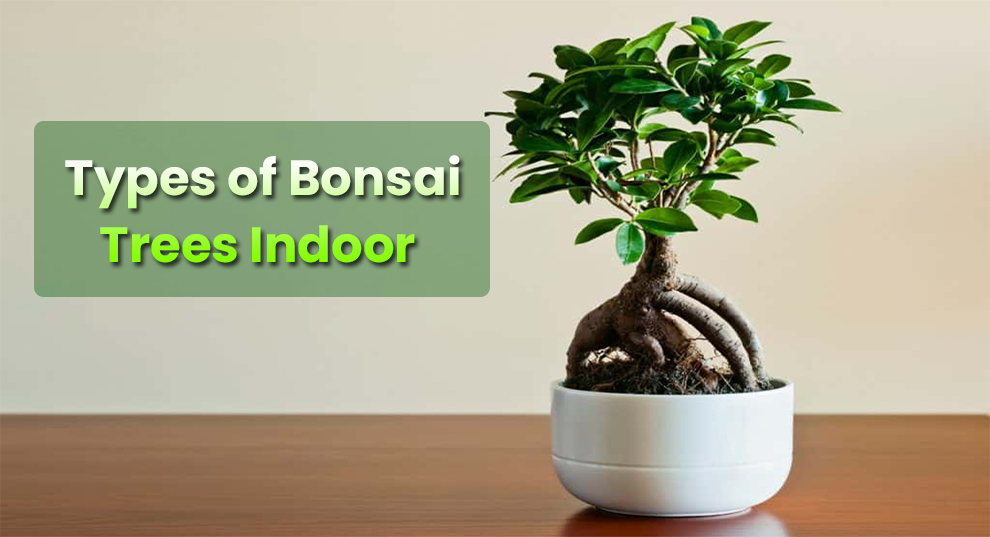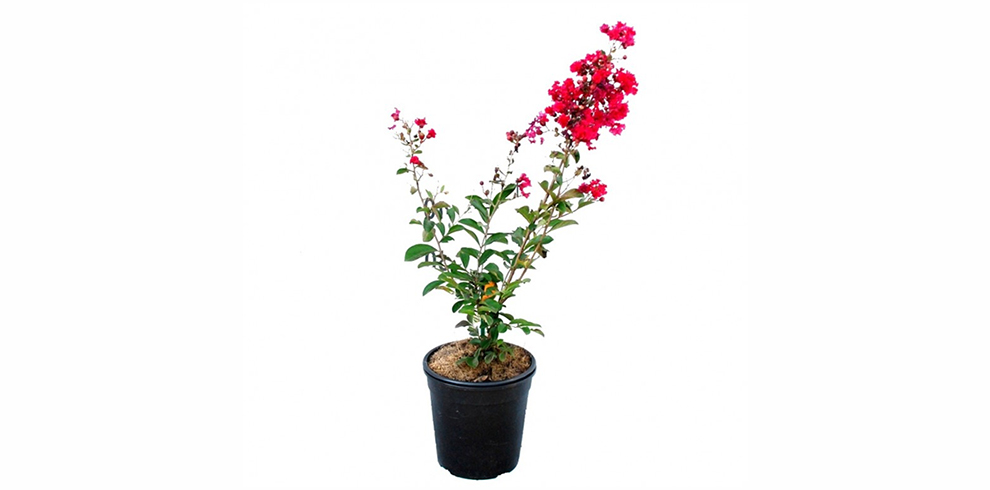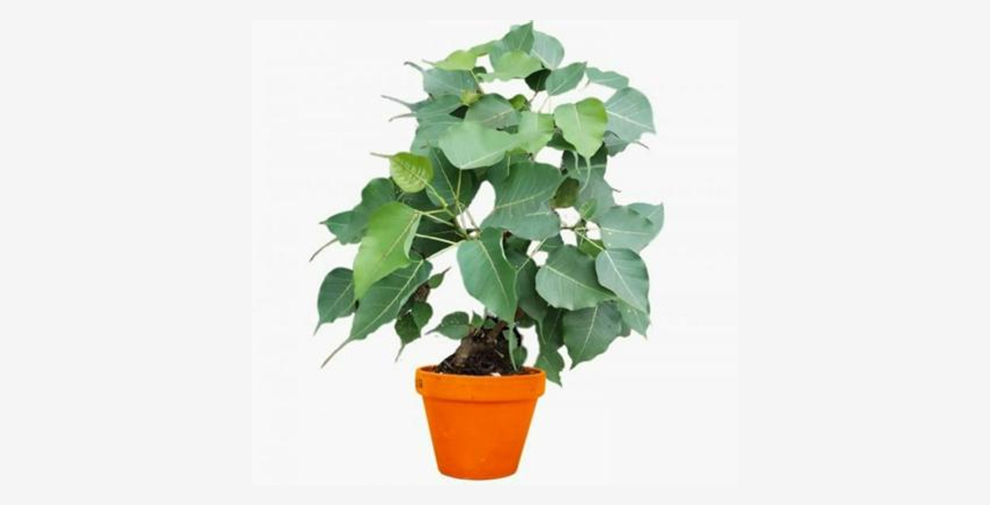Indoor Types of Bonsai Tree Species & Plant Varieties
Multiple varieties of plants can be put indoors as bonsai. Some of the best options you have are Ficus, Jade, Juniper Bonsai, Fukien Tree, and Chinese Elm. Each has its own unique characteristics, growth habits, and care requirements.

Bonsai trees have been a beloved art form in many cultures for centuries. These miniature trees are cultivated and trained to grow into intricate and beautiful shapes, often mimicking the appearance of full-sized trees found in nature.
Hundreds or even thousands of different species can be trained as bonsai, including tropical and subtropical trees, as well as some species of shrubs and succulents.
Some common types of bonsai trees indoors are Ficus Bonsai, Chinese Elm Bonsai, Jade Bonsai, Japanese Maple Bonsai, Juniper Bonsai, Schefflera Bonsai, and Serissa Bonsai, etc.
Today, we will be exploring these popular Bonsai trees, their features, and tips for growing and caring for these marvelous plants.
Is Bonsai Good Inside The House?
Yes, bonsai can be a great addition to the inside of a house, provided their needs are properly met.
Indoor bonsai can add a touch of nature and serenity to any space and can be an excellent way to bring the outdoors inside. Many indoor bonsai varieties are adapted to low light conditions as well and can thrive very well in the lower light levels of a typical indoor setting.
However, it’s important to keep in mind that bonsai are living plants that do require some care and attention.
Also, note that some indoor bonsai trees may require more light or humidity than others. It’s important to research the specific needs of the bonsai species you are considering to grow inside the house.
Types of Indoor Bonsai Plants
Here are some of the most popular indoor plants for bonsai.
- Juniper Bonsai
- Hawaiian Umbrella Bonsai
- Fukien Tree
- Chinese Elm
- Jade Plant
- Crape Myrtle
- Ficus Plant
- Ponytail Palm
- Japanese Flowering Cherry
- Snow Rose
- Bodhi
A. Juniper Bonsai
| Height | 6 to 12 inches tall |
| Care | Fun sun to partial shade, regular watering, and well-draining soil. |
| Leaves | Needle-like leaves |
Juniper bonsai is a type of bonsai tree that originates from Japan. It is a popular choice for bonsai enthusiasts due to its evergreen nature, needle-like leaves, and rugged appearance.
Juniper bonsai trees are known for their gnarled trunks and twisting branches, which can be shaped into various styles, including informal upright, slanting, and windswept.
Among the different types of indoor bonsai trees, Juniper bonsai love bright light. With proper juniper bonsai care and attention, it can thrive for many years, bringing a touch of natural beauty and serenity to any indoor space.
B. Hawaiian Umbrella Bonsai
| Height | 8 inches to 2 feet |
| Care | Bright and indirect sunlight, moist well-draining soil, fertilize periodically with balanced 10-10-10 fertilizer. |
| Leaves | Glossy, thin elongated leaves that grow in clusters. |
This bonsai tree has a compact, bushy appearance with glossy, elongated leaves that grow in clusters along the branches. The leaves of the Hawaiian Umbrella Bonsai can range in color from dark green to lighter shades of green or variegated with white or yellow.
The trunk of the Hawaiian Umbrella Bonsai is thick and textured, adding to its overall visual appeal. With proper pruning and training, the tree can be shaped into a variety of forms, including a windswept or cascade style.
Overall, the Hawaiian Umbrella Bonsai is a beautiful and easy-to-care-for indoor bonsai tree species that can add a touch of tropical beauty to any indoor space.
C. Fukien tree
| Height | 10 to 16 inches |
| Care | Warm and humid environment, Indirect sunlight, Moist and well-draining soil, Regular pruning. |
| Leaves | Glossy green, small, drop-shaped leaves with a pointed tip and a slightly serrated edge. |
The Fukien tea bonsai tree is one of the most popular indoor bonsai types known for its attractive glossy green leaves and white, star-shaped flowers that bloom throughout the year. The tree is native to China and is named after the Fujian province where it was first discovered.
The tree has a dense growth habit and small, delicate leaves that make it an ideal choice for bonsai cultivation.
Fukien tea bonsai trees require a warm, humid environment and indirect sunlight to thrive. They should be watered regularly to keep the soil moist but not waterlogged. Pruning and shaping of the tree should be done regularly to maintain its miniature size and desired shape.
D. Chinese elm
| Height | 6 to 10 inches |
| Care | Full sun to partial shade, Regular watering, fertilizing, and pruning. Use well-draining soil that is rich in organic matter. |
| Leaves | Small, oval-shaped leaves with serrated edges. The leaves are dark green and can turn shades of yellow and orange in the fall. |
The Chinese elm bonsai tree is a popular species for bonsai cultivation due to its hardiness, adaptability, and attractive appearance. The Chinese elm bonsai tree has small, oval-shaped leaves with serrated edges that are about 1-2 inches in length.
The leaves are dark green and can turn shades of yellow and orange in the fall. The tree’s bark is mottled and can vary in color from light gray to reddish-brown, adding to its aesthetic appeal.
This indoor bonsai tree species is relatively easy to care for. It prefers bright, indirect light and should be watered when the soil begins to feel dry to the touch. The tree should also be fertilized regularly during the growing season to support healthy growth and development.
Pruning and wiring should be done regularly to maintain the tree’s desired shape and size. Chinese elm bonsai trees should be loose and well-aerated to allow for good root growth and nutrient uptake.
E. Jade plant
| Height | Up to 1 meter on maturing. |
| Care | Bright, indirect sunlight, well-draining soil, regular pruning and fertilizing using a water-soluble, balanced fertilizer. |
| Leaves | Small, slightly rounded, or ovate leaves. The leaves are normally a glossy dark green color. |
The Jade Bonsai tree is one of the most popular indoor bonsai varieties that are known for its attractive appearance, easy maintenance, and longevity. This tree is also known as Crassula ovata or the “Money Tree.”
Jade Bonsai trees prefer bright, indirect sunlight and well-draining soil. They do well in a range of temperatures but prefer warmer temperatures, between 60-75°F. These trees can tolerate dry soil and infrequent watering, so it’s best to allow the soil to dry out between watering sessions.
Jade Bonsai trees are relatively disease-resistant and pest-free, but they may develop root rot if overwatered or placed in a poorly draining pot.
Overall, these types of bonsai trees indoor are a great choice for bonsai enthusiasts of all skill levels. With proper care and maintenance, it can live for many years and bring natural beauty to any indoor space.
F. Crape Myrtle

| Height | 1 to 2 feet tall |
| Care | Well-draining soil, bright light, and moderate watering. Fertilize every 2 weeks during spring. |
| Leaves | The leaves are oval-shaped and have a shiny, dark green color. In the fall, the leaves can turn to beautiful shades of orange, red, and yellow.
|
The trunk of the Crape Myrtle Bonsai is slender and can be trained to have a variety of shapes and styles, including informal upright, slanting, or cascade.
The leaves are oval-shaped and have a shiny, dark green color, which can turn to beautiful shades of orange, red, and yellow in the fall.
In the summer, these indoor types of bonsai trees produce stunning flowers that come in a wide range of colors, including pink, red, white, lavender, and purple.
Do check this out for more purple flower bonsai varieties.
The Crape Myrtle Bonsai tree prefers well-draining soil, bright light, and moderate watering. It can tolerate some drought, but it’s important not to let the soil dry out completely. In the winter, the Crape Myrtle Bonsai should be protected from frost.
G. Ficus plant
| Height | 8 to 24 inches (varies greatly) |
| Care | Bright, indirect sunlight, moist, well-draining, and slightly acidic soil re-pot every 2 to 3 years, fertilize every 2 weeks during the growing season. Pruning can be done throughout the year to keep the plant in shape. |
| Leaves | Dark green, small, pointed leaves. |
These tropical and subtropical trees can tolerate a wide range of environmental conditions, including low light and fluctuating temperatures, making them a great choice for beginners.
They can be trained in various styles, including formal upright, informal upright, slanting, and cascade. Ficus Bonsai trees can live for over 100 years and become treasured family heirlooms.
This indoor bonsai species prefer warm, humid environments with plenty of bright, indirect light. However, it would be wise to keep them away from drafty areas and extreme temperature fluctuations.
For Ficus Bonsai tree care, know that they prefer to be kept evenly moist, but not overly wet, as they can be sensitive to root rot.
Fertilization is required every two to four weeks during the growing season with a balanced, water-soluble fertilizer. Pruning and shaping are important for maintaining the size and shape of Ficus Bonsai trees and encouraging new growth
H. Ponytail palm
| Height | 1 to 3 feet |
| Care | Bright, indirect light, periodic watering, well-draining soil, and minimal pruning. |
| Leaves | The leaves are typically a blue-green or gray-green color, and they are long and narrow with a slight curve falling downwards |
Ponytail palm bonsai is a succulent plant that has a distinctive bulbous trunk that gives it a unique and interesting appearance.
The long, slender leaves of the Ponytail palm bonsai are often used to create the classic broom style in bonsai design. These trees are known for their hardiness and can tolerate a range of conditions, including low light and infrequent watering.
However, they prefer bright, indirect light and should be watered when the soil is dry to the touch. Ponytail palm bonsai are slow-growing, so they require minimal pruning and shaping.
They also do well in shallow pots with well-draining soil. With proper care and attention, Ponytail palm bonsai is one of the few indoor bonsai varieties that can live for many years and become treasured additions to any indoor space.
I. Japanese flowering cherry
| Height | 10 to 15 inches |
| Care | Well-draining soil with good water retention, full exposure to sunlight, humid environment with regular watering. |
| Leaves | Small and oval-shaped leaves with a glossy green color that turns to shades of yellow, orange, and red in the fall. |
The Japanese flowering cherry bonsai plant, also known as Sakura bonsai, is a popular species of bonsai tree that is native to Japan. The plant has stunning pink and white blossoms, which bloom in the spring and are a symbol of renewal in Japan.
The leaves of the Japanese flowering cherry bonsai are small and oval-shaped, with a glossy green color that turns to shades of yellow, orange, and red in the fall.
These indoor bonsai species thrive in well-draining soil with good water retention. The plant requires a lot of sunlight, so it is best to place it in a location that receives full sun for at least six hours a day.
The bonsai should be watered regularly, but care should be taken not to overwater the plant as it can cause root rot.
J. Snow Rose
| Height | 6 to 18 inches |
| Care | Bright, indirect light, moist, well-drained soil, warm humid environment. Regular pruning is essential. |
| Leaves | Leaves are dark green, small, oval-shaped, glossy, and densely packed along the stems, creating a full and bushy appearance. |
Snow Rose is a common indoor bonsai species with small, dark green leaves and delicate, white flowers that bloom in the summer. The Snow Rose bonsai is highly prized for its attractive, miniature size, and beautiful, intricate branching patterns.
Snow Rose bonsai plants thrive in bright, indirect light, with a recommended minimum of four hours of sunlight each day. They also prefer consistently moist but well-drained soil, as the plant is sensitive to overwatering and prone to root rot.
Pruning encourages branching and denser foliage, while wiring helps to shape the branches and create the desired aesthetic.
K. Bodhi

| Height | 6 inches (smaller trees) to 2 feet (older trees) |
| Care | Bright and indirect sunlight, moist soil (but shouldn’t be waterlogged), occasional fertilization, and replantation every few years. |
| Leaves | Heart-shaped, bright green leaves. |
Bodhi indoor bonsai types have heart-shaped leaves that are typically a bright green color and grow densely on the branches. The tree’s trunk is often twisted and gnarled, giving it a unique and striking appearance.
While the Bodhi bonsai tree is a beautiful and meaningful choice, it does require some care and attention to thrive. Bodhi bonsai trees prefer bright, indirect light and require regular watering to keep the soil moist but not waterlogged.
They can also benefit from occasional fertilization and should be repotted every few years to ensure that the soil remains fresh and nutrient rich. With proper care and attention, a Bodhi bonsai tree can thrive for many years.
Some other plants that can be grown indoors as a bonsai include Boxwood, Indian Laurel Fig, Dwarf Schefflera, Common Beech, Pachira Bonsai, Satsuki azalea, Pine Bonsai, and Japanese Maple Bonsai.
| Did You Know??
Bonsai trees not only beautify your indoors, but they also absorb pollutants such as formaldehyde, benzene, and carbon monoxide, which are commonly found in indoor air. Also, the act of caring for a bonsai plant can be a stress-relieving activity and can improve mental health. |
Which Are The Best Indoor Types Of Bonsai Trees For Beginners?
One of the best indoor bonsai trees for beginners that are easy to care for is the Ficus bonsai tree.
Ficus trees are relatively low maintenance and can adapt to a range of indoor environments, including low-light conditions. They are forgiving of some degree of neglect and can recover well if they are not watered on a strict schedule.
Ficus bonsai trees are also tolerant of pruning mistakes, and their leaves can regrow quickly if cut back too far. Additionally, Ficus bonsai trees are widely available and relatively inexpensive compared to some other types of bonsai, making them a great choice for beginners who are just starting with bonsai.
Apart from Ficus, you could also go for a dwarf jade bonsai since you won’t have to worry about keeping it short. They by default don’t grow tall.
Other bonsai plants good for beginners include Chinese Elm and Hawaiian Umbrella Bonsai.
Related: Bonsai Tree in Winter |Outdoor Bonsai Varieties |Flowering Bonsai Types
Which Is The Best Indoor Bonsai Species For Indoor Low Light?
One of the best indoor low-light bonsai trees is the Chinese Elm. The Chinese Elm is a hardy and adaptable species that can thrive in a range of indoor lighting conditions, including low light.
This makes it an excellent choice for indoor bonsai enthusiasts who do not have access to bright, direct sunlight.
Other bonsai plants that thrive in low light include ponytail palm bonsai, Ficus bonsai, and ZZ plant bonsai.
